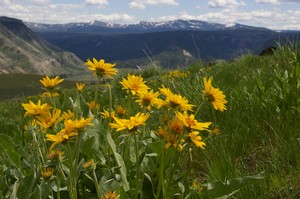 In the high altitudes of Yellowstone, the long winter gives way reluctantly to the warmer seasons. Brilliant spring flowers are showcased against a backdrop of mountains still highlighted by snow, making this a wonderful time to be here.
In the high altitudes of Yellowstone, the long winter gives way reluctantly to the warmer seasons. Brilliant spring flowers are showcased against a backdrop of mountains still highlighted by snow, making this a wonderful time to be here.
As we wend our way through open Ponderosa Pine forest and across wide open meadows on the Beaver Ponds Trail, carpets of yellow Arrowleaf Balsamroot line the path, stretching in swathes across the hillsides. Small groups of elk feed and rest under the protection of trees along the edge of the more open areas: they watch as we pass but seem largely unconcerned.
 Emerging from the woods for a lunch stop, we sit quietly munching our sandwiches stilled by the view before us: fast moving clouds pattern the sky casting shadows across the land, distant snow edged mountains form the horizon, rounded hills clothed in pale greens mix with the yellows and creams of bare rock in a fascinating mosaic and horizontal strata cut a vertically washboarded valley side while the grey sagebrush and yellow flower heads blanket the immediate foreground.
Emerging from the woods for a lunch stop, we sit quietly munching our sandwiches stilled by the view before us: fast moving clouds pattern the sky casting shadows across the land, distant snow edged mountains form the horizon, rounded hills clothed in pale greens mix with the yellows and creams of bare rock in a fascinating mosaic and horizontal strata cut a vertically washboarded valley side while the grey sagebrush and yellow flower heads blanket the immediate foreground.
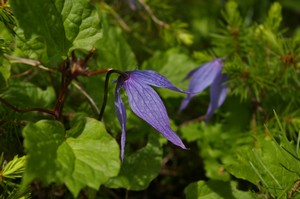 Near the ponds for which the trail is named, there are further prolonged stops as we photograph wild penstemon and clematis but in spite of the presence of old beaver workings the animals themselves are not in evidence.
Near the ponds for which the trail is named, there are further prolonged stops as we photograph wild penstemon and clematis but in spite of the presence of old beaver workings the animals themselves are not in evidence.
Progress can be almost as slow out on the roads. An animal sighting results in a car pulling off to the side of the road. A bear has been spotted in the distance. Before too long thirty or forty cars have joined the first and the road is virtually impassable. In the big western parks, this is known as a bear jam.
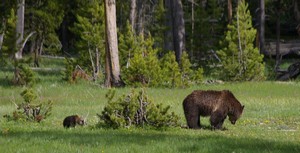 Driving home one afternoon we fight our way through such a congestion, inching past on-coming tour buses, narrowly missing protruding mirrors, opening doors and people crossing with little regard for vehicles still on the move. As I attempt to remain calm and avoid any collisions Sterling manages to snap a few shots of the grizzly and cub. They're too far off even for our telephoto lens and we are set to jonesing for a better one.
Driving home one afternoon we fight our way through such a congestion, inching past on-coming tour buses, narrowly missing protruding mirrors, opening doors and people crossing with little regard for vehicles still on the move. As I attempt to remain calm and avoid any collisions Sterling manages to snap a few shots of the grizzly and cub. They're too far off even for our telephoto lens and we are set to jonesing for a better one.
The following day we again find ourselves wishing for greater zoom. A group of elk that meander about the busy Mammoth Springs area have very young calves.
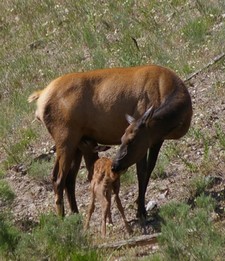 They're still unsteady on their long spindly legs, the uneven ground posing a challenge. They are a delight to watch. A cow moves ahead, the uncoordinated young following closely behind. Before too long they come back together, the cow licking her calf as it hungrily suckles.
They're still unsteady on their long spindly legs, the uneven ground posing a challenge. They are a delight to watch. A cow moves ahead, the uncoordinated young following closely behind. Before too long they come back together, the cow licking her calf as it hungrily suckles.
Of course Yellowstone is most famous for its hydrothermal features and even in these areas the flora and fauna of the park are evident.
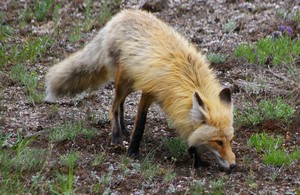 Flowers grow on the seemingly inhospitable slopes of Mammoth Hot Springs, Mountain Blue birds rummage for nesting material nearby while Killdeer wade in the hot water feeding on bugs whilst also keeping their feet toasty warm. From the higher boardwalks, we spot a red fox. After a quick glance to make sure we pose no threat, she continues tracing her way back and forth sniffing the ground as she goes, passing just in front of us before heading off across the terraces and curves of the mineral deposits.
Flowers grow on the seemingly inhospitable slopes of Mammoth Hot Springs, Mountain Blue birds rummage for nesting material nearby while Killdeer wade in the hot water feeding on bugs whilst also keeping their feet toasty warm. From the higher boardwalks, we spot a red fox. After a quick glance to make sure we pose no threat, she continues tracing her way back and forth sniffing the ground as she goes, passing just in front of us before heading off across the terraces and curves of the mineral deposits.